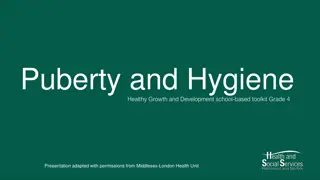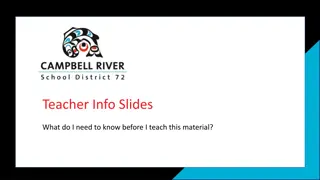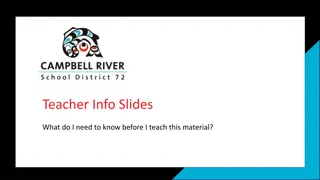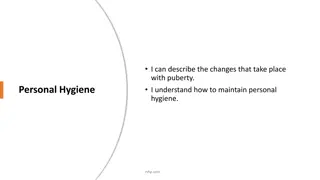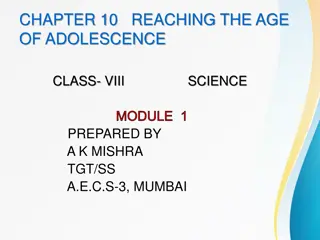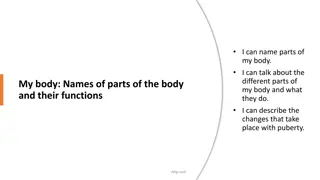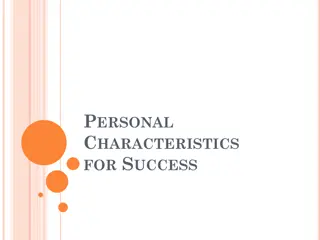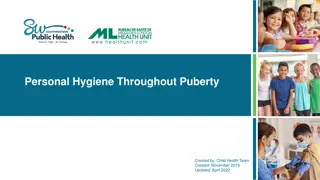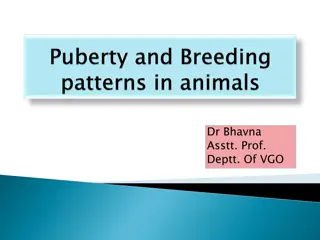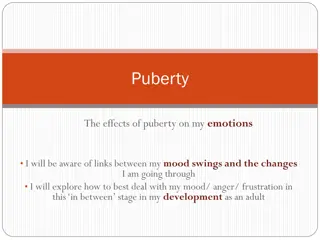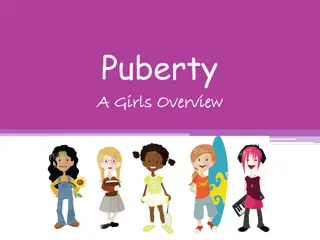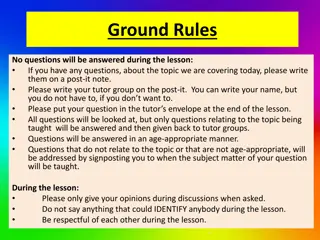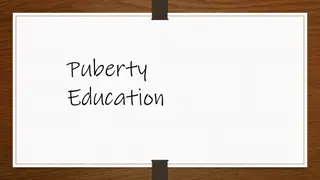Puberty/Human Development
Explore the changes and challenges of puberty and human development in adolescence. Learn about physical, emotional, and social transformations during this crucial stage. Understand the importance of hygiene, setting goals, and cultivating a positive self-concept. Discover the significance of nutrition and the stages of the life cycle from birth to teenage years. Gain insight into the sweat glands, physical changes for girls, and essential reproductive system vocabulary.
Download Presentation

Please find below an Image/Link to download the presentation.
The content on the website is provided AS IS for your information and personal use only. It may not be sold, licensed, or shared on other websites without obtaining consent from the author.If you encounter any issues during the download, it is possible that the publisher has removed the file from their server.
You are allowed to download the files provided on this website for personal or commercial use, subject to the condition that they are used lawfully. All files are the property of their respective owners.
The content on the website is provided AS IS for your information and personal use only. It may not be sold, licensed, or shared on other websites without obtaining consent from the author.
E N D
Presentation Transcript
Puberty/Human Development Grade 6
Changes in Early Adolescence What changes that will happen to your bodies Hygiene How to set goals Steps to develop a positive self-concept Nutrition
The Life Cycle Birth-early/childhood And Late childhood/teenage These two stages have the most growth
Do you have questions in how we change from a baby to an adult?
Hygiene Daily bathing washing removes dirt/oil and reduces bacteria Using a deodorant or deodorant/anti- perspirant Change into clean clothes
Sweat Glands Eccrine glands Produce clear, odorless sweat Have been active since childhood Located all over the body Help to control body temperature, eliminate water, salt, and waste products
Sweat Glands Aprocrine glands These become active during puberty Located under the arms and in the genital area This perspiration causes body odor when it comes into contact with bacteria
Physical Changes at Puberty for Girls The Five Tanner stages of development Each girl s progression through the stages will be slightly different according to her own body s timetable
Vocabulary Cervix base of the uterus that has a small opening into the vagina Egg also called an ovum; the female reproductive cell Fallopian tubes two tubes connecting the ovaries to the uterus through which the egg travels Ovary two glands, one on either side of the uterus, that contain a woman s egg cells and produce the hormones estrogen and progesterone Uterus also called the womb; a muscular organ lines with soft nourishing tissue that carries the fetus until birth Vagina the flexible passageway leading from the cervix to the outside of the body. Menstrual fluid flows out of the body through this
Physical Changes at Puberty for Boys Each boy s progression through the stages will be slightly different according to his own body s timetable
Vocabulary Scrotum sac of skin that holds the testicles, just underneath the penis Seminal vesicles two glands on either side of the bladder that secrete seminal fluid Sperm male reproductive cell Testicles also called the testes; two oval-shaped organs that are contained in the scrotum. They produce the male hormone testosterone and sperm. Penis male sex organ; also used to urinate Prostate gland gland next to the bottom of the bladder; it forms a fluid that combines with sperm and a fluid from the seminal vesicles to make semen Urethra tube that, at different times, carries urine and semen out of the body Vas deferens tubes in which sperm is combined with other fluids form the prostate gland and seminal vesicles to make semen
Nutrition Five main food groups 1. grains 6 servings a day 2. fruits 4 servings a day 3. vegetables 3-4 servings a day 4. dairy 2-3 servings a day 5. meat 3-6 oz a day
Calcium Remember to consume about 1,300 mg of calcium per day Foods that include calcium: Milk, whole, lowfat, skim, yogurt, cheese, broccoli, almonds, milkshakes, pudding, frozen yogurt, ice cream
10 Steps to Self-Esteem 1. Know Yourself 2. Understand what makes you feel great 3. Recognize the things that get you down 4. Set goals to achieve what you want
Self-Esteem continued 5.Developing trusting friendships that make you feel good 6.Don t be afraid to ask for help 7.Stand up for your beliefs/values 8.Help someone else 9.Take responsibility for your actions
10. Take Good Care of Yourself Eating properly Getting enough rest Clean, well-groomed appearance Learn what your body needs to stay healthy and fit Exercise/relaxation activities




